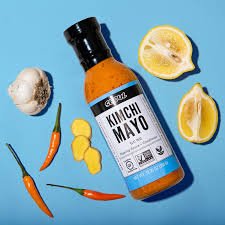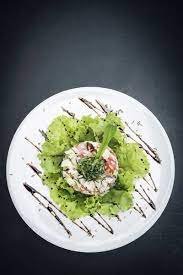Introduction of Mayonnaise
Mayonnaise, a creamy and beloved condiment, is made from a simple blend of egg yolk, oil, and vinegar or lemon juice. It is widely loved in different countries and cuisines. But did you know there are many exciting variations of mayonnaise around the world? In this blog, we will take a delightful journey to discover these unique mayo flavors, explore their history, and learn how they are used in different cultures. Each culture brings its own twist to this delightful concoction, incorporating a medley of local flavors and ingredients that turn mayonnaise into a culinary adventure. The Wonderful World of Mayonnaise: Exploring Unique Variations From Around the Globe
I. What Makes Mayonnaise and Its Origins
Mayonnaise may seem plain, but it has a fascinating science behind it. It is created by mixing egg yolks, oil, and vinegar or lemon juice to form a smooth and creamy sauce. The egg yolks act as emulsifiers, helping to bind the oil and liquid together. The acid from vinegar or lemon juice adds flavor and balances the richness of the oil. The whisking action during preparation gradually incorporates oil droplets into the mixture, resulting in the velvety texture we all love.
The origins of mayonnaise can be traced back to France in the 18th century. The name “mayonnaise” is believed to have derived from the French word “moyeu,” meaning egg yolk. It was popularized by the French chef Marie-Antoine Carême, who introduced it as a culinary marvel. Over time, as European explorers traveled the globe, they brought mayonnaise to new cultures and regions, leading to its global presence today.
II. Traditional Mayonnaise Recipes
While the classic mayo recipe is simple and well-known, there are unique variations of this creamy condiment from different cultures.

A. Making Classic Mayonnaise
To make classic mayo, whisk egg yolks, mustard, and vinegar or lemon juice together in a bowl. The mustard acts as an emulsifier aid, helping to stabilize the mixture. Slowly add oil while whisking vigorously until the ingredients emulsify and thicken into a creamy sauce. Patience and steady whisking are key to achieving the perfect texture.
B. Different Mayo Styles Around the World
In addition to the classic recipe, various cultures have their own take on mayo, incorporating local flavors and ingredients. In France, “Sauce Mayonnaise” forms the foundation of many French sauces and dressings. It serves as a base for classic French accompaniments like aioli and remoulade.
Spain has its version called “Alioli,” which originates from Catalonia. Alioli is a garlic-infused mayo made with olive oil, garlic, and sometimes lemon juice. It is a popular dip for seafood and vegetables, and its rich garlic flavor adds a delightful punch to dishes.
In Japan, “Wasabi Mayo” is a favorite variation that blends the fiery kick of wasabi with the creamy mayo base. It is often served with sushi, tempura, and other Japanese dishes, adding a zesty and spicy twist to the flavors.
III. Exotic Mayonnaise Flavors
Prepare to embark on a flavorful journey as we explore exotic mayo variations from different corners of the world.

A. Exciting Mayo Variations
Japan’s “Wasabi Mayo” combines the creaminess of mayo with the fiery spiciness of wasabi, making it a popular choice to accompany sushi and tempura. The wasabi mayo adds a zesty and refreshing kick to the traditional dishes.
India’s “Curry Mayo” infuses the creamy mayo with a blend of aromatic spices like cumin, coriander, turmeric, and more. This unique variation complements kebabs, wraps, and other Indian delicacies, enhancing their flavors with a touch of curry.
South America’s “Chimichurri Mayo” marries the traditional chimichurri sauce with creamy mayo. The result is a mayo variation bursting with the flavors of parsley, garlic, and tangy vinegar, making it a perfect pairing for grilled meats and vegetables.
B. Unique Ingredients in International Mayonnaise

One of the reasons for the diverse flavors of mayo around the world lies in the use of unique ingredients. In South Africa, “Peri-Peri Mayo” brings the fiery heat of peri-peri chilies into the mix, creating a mayo with a bold and unforgettable kick. The peri-peri mayo is a popular choice to accompany grilled meats and sandwiches, adding a burst of flavor to every bite.
The Middle East’s “Toum” is another distinctive variation that elevates the creamy mayo with the richness of garlic and lemon. Toum is a beloved sauce in Lebanese and Middle Eastern cuisines, known for its robust garlic flavor. It is a delightful pairing with shawarma, falafel, and grilled vegetables.
IV. Beyond the Ordinary: Unconventional Mayo Uses
Mayonnaise is more versatile than you might think, going beyond being a mere sandwich spread or salad dressing.

A. Creative Mayo Uses
In addition to its traditional uses, mayonnaise shines in baking and as a marinade. When used in baking, mayo adds moisture and richness to cakes and cupcakes, creating tender and flavorful desserts. Its emulsified texture helps in creating smooth and well-incorporated batters.
Mayo’s versatility also extends to marinades, where its creaminess acts as an excellent tenderizer for meat and poultry. The vinegar or lemon juice in mayo helps to break down the protein fibers, resulting in tender and juicy meat.
In addition to its traditional uses, mayonnaise shines in baking and as a marinade. When used in baking, mayo adds moisture and richness to cakes and cupcakes, creating tender and flavorful desserts. Its emulsified texture helps in creating smooth and well-incorporated batters.
B. Surprising Mayo Recipes
Discover some surprisingly delightful mayo-infused recipes that will surely captivate your taste buds:
Chocolate Mayo Cake: This intriguing dessert fuses the creaminess of mayo with the indulgence of chocolate, resulting in a moist and delightful cake that will leave you craving for more.
Grilled Shrimp with Lemon Dill Mayo: The tangy dill mayo complements the succulent grilled shrimp perfectly, elevating the dish to new heights of flavor.
Mayonnaise Ice Cream: Yes, you read it right! The velvety texture of mayo creates a surprisingly delightful ice cream that will surely surprise and impress your guests.
V. Healthier Mayo Options
While traditional mayo is undeniably delicious, some health-conscious individuals may seek healthier alternatives to reduce fat and calorie intake.
A. Reducing Fat and Calories
Traditional mayo can be high in fat and calories due to its oil content. For those looking to reduce their fat and calorie intake, there are healthier mayo options available.
B. Healthier Mayo Variations
“Avocado Mayo” is a popular alternative that replaces some or all of the oil with ripe avocados. Avocado is rich in healthy monounsaturated fats, and it adds a buttery richness to the mayo, making it a nutritious and flavorful option.
“Greek Yogurt-based Mayo” is another healthier alternative. It incorporates Greek yogurt, which offers protein and probiotics. This mayo variation provides a tangy and creamy texture while reducing the overall fat content.
VI. Famous Mayo-Based Sauces and Dressings

Discover a variety of sauces and dressings that use mayo as a base, adding creaminess to various dishes.
A. The Versatility of Mayo-Based Sauces
One of the reasons for mayo’s popularity is its versatility in making delightful sauces. These sauces can elevate the flavors of dishes and add a creamy touch to various meals.
B. Classic Sauce Recipes
Some famous mayo-based sauces include:
Thousand Island Dressing: A classic dressing made by combining mayo, ketchup, sweet pickle relish, and other flavorful ingredients. This sweet and tangy dressing is commonly used in salads, burgers, and sandwiches.
Remoulade: A savory mayo-based sauce infused with capers, mustard, and spices. It is a versatile sauce that pairs beautifully with seafood dishes, adding a burst of flavor to shrimp, fish, and crab cakes.
VII. Mayo in Different Cultures
Mayo has integrated into various cultures, becoming a part of traditions and celebrations.
A. Mayo in Culture and Tradition
In the Netherlands, “Fritesaus” is a popular mayo-based sauce often served with fries. In Russia, mayo is frequently paired with “Syrniki,” a type of small, fried quark pancakes, creating a delightful combination of flavors.
B. Mayo in Festivals and Celebrations
In Latin America, “Ensalada Rusa” (Russian salad) becomes a must-have dish during holidays and gatherings. This mayo-based salad combines vegetables, potatoes, and protein, creating a colorful and refreshing dish that celebrates the abundance of fresh produce.
In Japan, “Kewpie” mayo holds a special place in the hearts of food enthusiasts and home cooks alike. The iconic red-capped squeeze bottle of Kewpie mayo is a staple in Japanese households and is often featured in festive dishes, sushi rolls, and salads.
VIII. DIY Mayo Adventures
Take the culinary reins and experiment with making your mayo creations.
A. Get Creative with Mayo
Mayo’s versatility makes it a perfect canvas for culinary experiments. Dare to try new combinations of spices, herbs, and other condiments to create your signature mayo. Whether you choose to explore classic flavor combinations or invent your own, making your own mayo opens up a world of culinary possibilities.
B. Homemade Mayo Variations
Here’s a secret: Making homemade mayonnaise is surprisingly simple and rewarding. By making your own mayo, you have complete control over the ingredients and flavors, allowing you to tailor it to your preferences.
Classic Homemade Mayo

Ingredients:
2 large egg yolks, at room temperature
1 tablespoon Dijon mustard
1 tablespoon white wine vinegar or lemon juice
1 cup vegetable oil (sunflower, safflower, or grapeseed)
Salt, to taste
Instructions:
In a medium-sized mixing bowl, whisk together the egg yolks, Dijon mustard, and vinegar or lemon juice until well combined.
Slowly add the vegetable oil to the egg yolk mixture in a thin, steady stream, whisking constantly to emulsify the mixture. As you whisk, the mixture will gradually thicken and become creamy.
Continue adding the oil until you’ve reached the desired consistency. The mayo should be creamy and thick but still pourable. If it becomes too thick, you can add a few drops of water to loosen it up.
Season the mayo with salt to taste, and whisk it in until well incorporated.
Congratulations! You’ve made a classic homemade mayo that serves as the perfect base for your culinary creations.
Flavorful Homemade Mayo Variations
Now that you have your classic mayo, it’s time to get creative with flavor combinations. Here are a few ideas to get you started:
Garlic Herb Mayo: Add minced garlic and a blend of fresh herbs like parsley, chives, and dill to the classic mayo for a burst of savory goodness. This herby mayo is fantastic as a spread for sandwiches or as a dip for vegetable sticks.
Spicy Chipotle Mayo: Incorporate chipotle pepper in adobo sauce for a smoky and spicy twist on the classic mayo. This fiery mayo adds a delightful kick to burgers, tacos, and grilled meats.
Lemon Basil Mayo: Infuse the mayo with the refreshing zest of lemon and the aromatic notes of fresh basil. This lemony mayo pairs beautifully with seafood, grilled chicken, and even pasta dishes.
Remember, the key to experimenting with mayo flavors is to start with a small amount of the added ingredient and adjust to your taste preferences. Whether you choose to explore classic flavor combinations or invent your own, making your own mayo opens up a world of culinary possibilities.
Famous Mayonnaise Brands
Here are numerous well-known mayo brands that are popular worldwide. Some of the famous mayo brands include:
Hellmann’s (also known as Best Foods in some regions) – A widely recognized and trusted brand, known for its creamy and rich mayonnaise.
Kraft – Known for its creamy texture and balanced flavor, Kraft is a popular choice for many consumers.
Duke’s – A beloved Southern brand, Duke’s Mayo is celebrated for its tangy and distinctive taste.
Kewpie – A Japanese brand famous for its rich and creamy mayo, often served in a distinctive red-capped squeeze bottle.
Heinz – Known for its high-quality condiments, Heinz mayo offers a creamy and smooth texture.
Sir Kensington’s – A premium brand that focuses on using high-quality ingredients and sustainable practices to create unique mayo flavors.
Blue Plate – A classic mayo brand that originated in New Orleans, known for its deliciously creamy texture.
Miracle Whip – Although not a traditional mayo, Miracle Whip is a popular sandwich spread that combines mayo-like creaminess with a tangy and sweet flavor.
Trader Joe’s – A beloved grocery store brand that offers its own version of mayo with various flavor options.
Best Foods – The same brand as Hellmann’s but known as Best Foods in some parts of the United States.
IX. Conclusion
We’ve explored the wonderful world of mayonnaise, discovering unique variations from different cultures. Mayonnaise’s versatility has made it a beloved condiment around the globe. So, whether you enjoy classic mayo or adventurous flavors, let mayo continue to be a delightful part of your culinary journey.
Mayonnaise’s magic lies not only in its creamy texture and tangy taste but also in its ability to unite people from different backgrounds through the love of good food. So, the next time you savor a sandwich or dress a salad, remember the mayo medley that brings the world’s flavors together on your plate.
As you continue your culinary adventures, don’t be afraid to explore, experiment, and embrace the diverse world of mayonnaise. Whether you’re mixing up a traditional batch or adding a unique twist, mayonnaise remains an ever-present companion in kitchens worldwide.
Let your taste buds travel the world through the mayo medley, celebrating the global flavors and cultural significance of this beloved condiment. And, as you experiment with your homemade mayo creations, share your culinary discoveries with friends and family, inspiring them to embark on their mayo adventures.

Bon appétit
Birendra Singh Head Consultant
Gourmet Guys Restaurant and Hospitality Consultanthttp://www.gourmetguys.in
